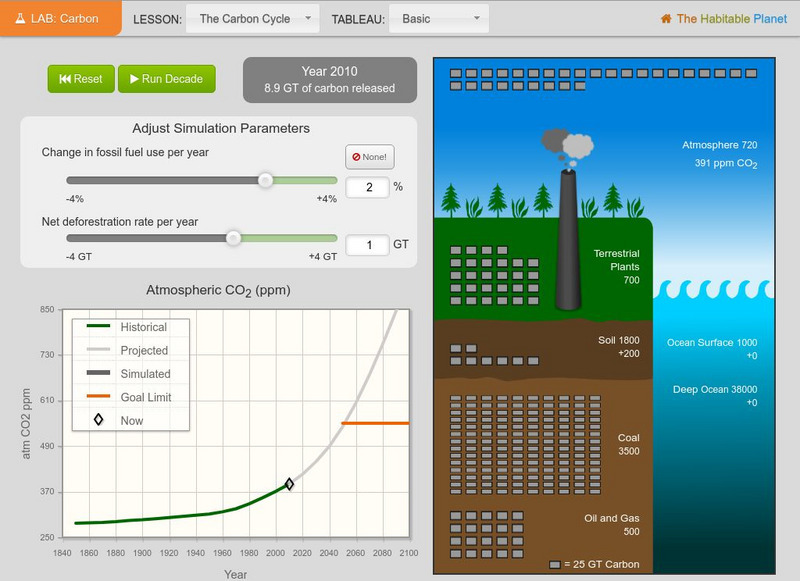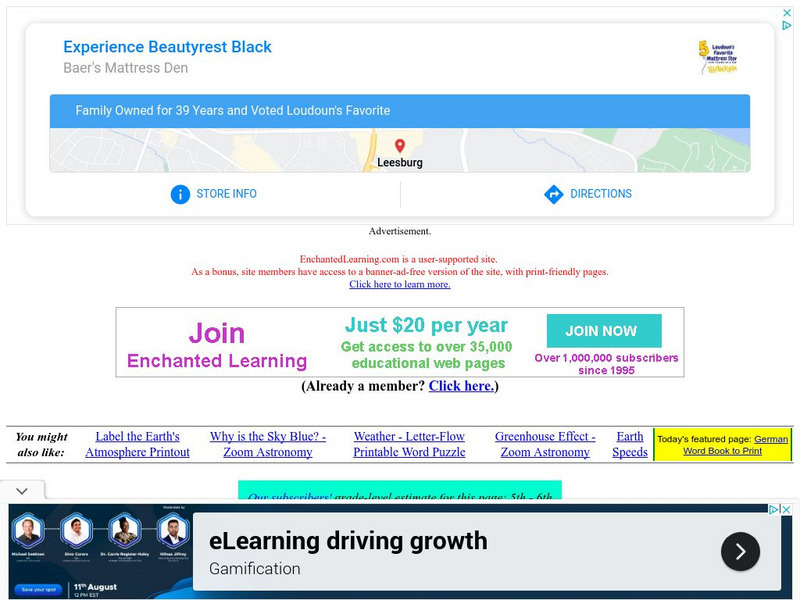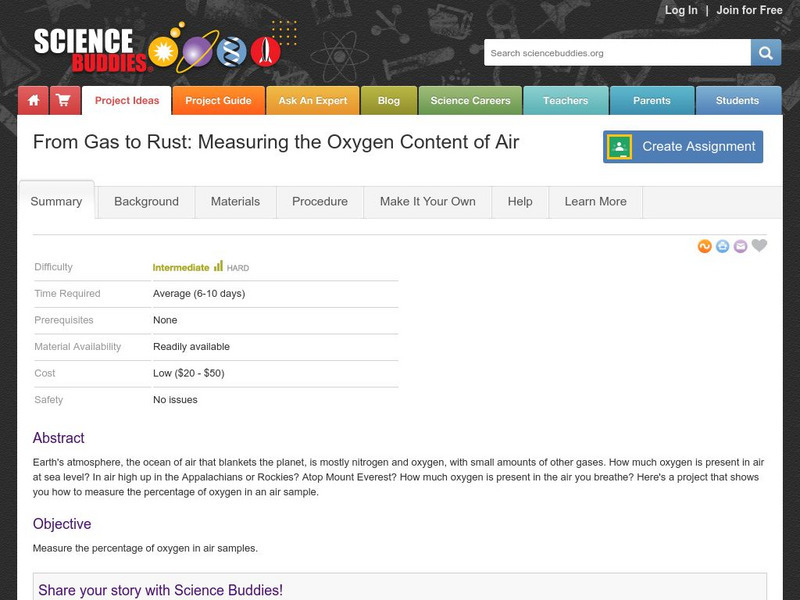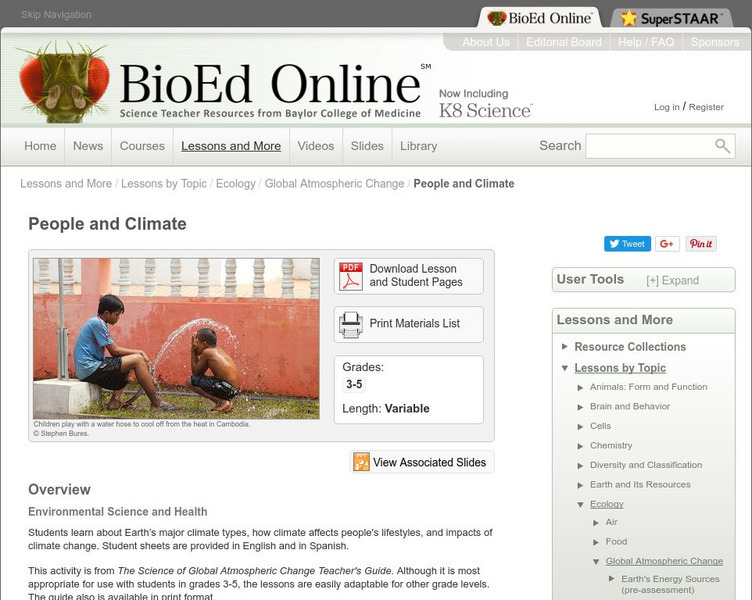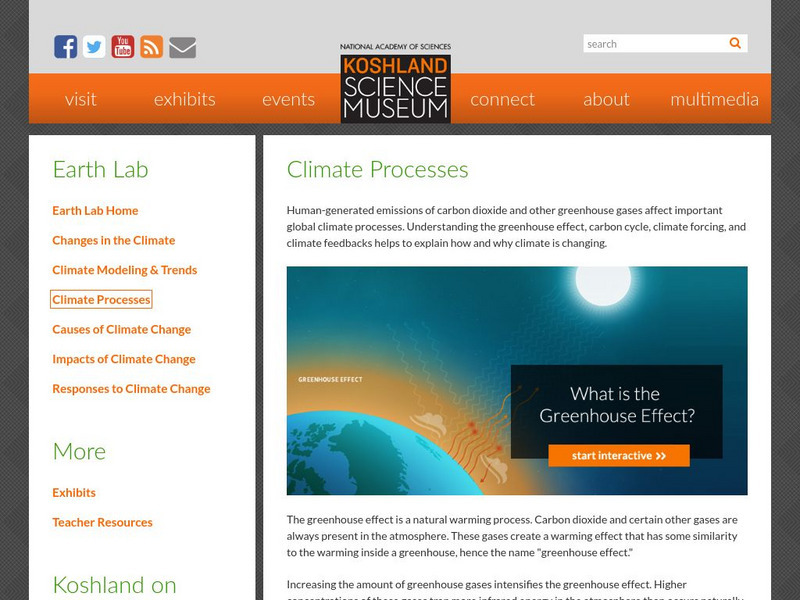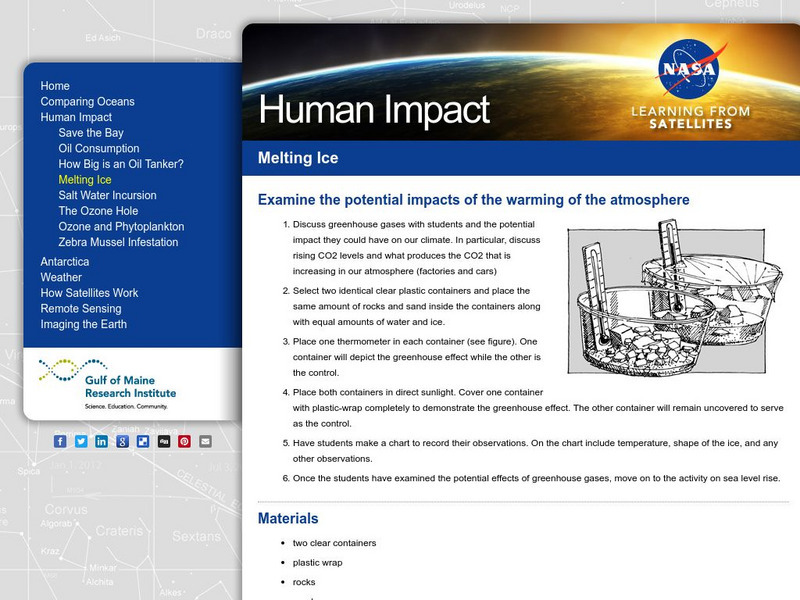University Corporation for Atmospheric Research
Ucar: What Do Soda and the Oceans Have in Common?
Students will use soda to explore how carbon dioxide is able to dissolve into liquid. They will learn about Henry's law, which describes how the solubility of gas into liquids is dependent on temperature and develop hypotheses about how...
Annenberg Foundation
Annenberg Learner: The Carbon Cycle
This lab uses a robust model of the carbon cycle to give students an intuitive sense for how carbon circulates through the atmosphere, biosphere, oceans, and crust. It allows them to experiment with how human input to the cycle might...
Simon Fraser University
Chem1 Virtual Textbook: Observable Properties of Gases
The General Chemistry Virtual Textbook, or Chem 1, is broken into several sections covering various aspects of topics related to chemistry. This section deals specifically with the properties of gases including subtopics such as the...
King's Centre for Visualization in Science
Explaining Climate Change: Lesson 3: The Chemistry of the Greenhouse Effect
This is the third lesson in a series of learning modules on the topic of climate change. It takes a look at how greenhouse gases cause warming and affect Earth's climate. Includes comprehension questions and interactive tools for...
University Corporation for Atmospheric Research
Ucar: Comparing Planetary Gases
Use jelly beans to compare the compositions (amounts of different gases) of the atmospheres of Earth, Mars, and Venus.
Georgia Department of Education
Ga Virtual Learning: Ap Environmental Science: Air Pollution and Climate Change
Through this interactive module, students learn that the atmosphere is so much more than air, its complex role on Earth should be explored, and its quality carefully monitored and protected.
Enchanted Learning
Enchanted Learning: The Earth's Atmosphere
The Earth's atmosphere is a thin layer of gases that surrounds the Earth. It composed of 78% nitrogen, 21% oxygen, 0.9% argon, 0.03% carbon dioxide, and trace amounts of other gases. This thin gaseous layer insulates the Earth from...
Science4Fun
Science4 Fun: Atmosphere
What is atmosphere? Find out about the layers of the atmosphere and learn how the atmosphere protects life on Earth and other fun facts.
Science Buddies
Science Buddies: From Gas to Rust: Measuring the Oxygen Content of Air
Earth's atmosphere, the ocean of air that blankets the planet, is mostly nitrogen and oxygen, with small amounts of other gases. How much oxygen is present in air at sea level? Is air high up in the Appalachians or Rockies? Atop Mount...
BioEd Online
Bio Ed Online: The Science of Global Atmospheric Change: People and Climate
The impact that climate and climate change have on humans is explored in this lesson. Learners learn about climate zones, and factors that affect climate, e.g., proximity to the ocean and greenhouse gases. The lesson and accompanying...
BioEd Online
Bio Ed Online: Finding the Carbon in Sugar
Students learn that fossil fuels release energy when they are burned, and this takes the forms of light, heat, gases, etc. For this lesson they explore combustion with a candle and with sugar. The lesson and accompanying PowerPoint can...
Thinkport Education
Thinkport: Made Clear: What Are Greenhouse Gases?
Learn how greenhouse gases help keep the Earth warm.
University Corporation for Atmospheric Research
Ucar: What's in the Air?
Air is a mixture of naturally occurring gases and human-made air pollutants. Learn more about these gases and the role they play in our atmosphere.
King's Centre for Visualization in Science
Explaining Climate Change: Lesson 2: Is Climate Change Happening?
This is the second lesson in a series of learning modules on the topic of climate change. It examines what climate change is, how it relates to greenhouse gas concentrations over time, and temperature trends. Includes comprehension...
Other
The Greenhouse Effect: Natural and Amplified Warming
This concise resource presents a thorough drawing which simplifies the explanation of the greenhouse effect into six easy to understand steps.
Concord Consortium
Concord Consortium: Stem Resources: Greenhouse Gases
Do you understand the relationship between temperature and carbon dioxide in our atmosphere? This computer model shows factors such as clouds and carbon dioxide that could cause global temperatures to rise. Students investigate how the...
Science Education Resource Center at Carleton College
Serc: Analyzing Greenhouse Gases and Global Temperature Data Over Time
In this activity, learners plot data on the concentrations of various greenhouse gases in Earth's atmosphere and look for trends. They will learn that greenhouse gases allow the Sun's light to pass through them to the surface of Earth,...
University Corporation for Atmospheric Research
Ucar: The Greenhouse Effect
Students will learn how greenhouse gases temporarily trap heat within Earth's atmosphere, warming the planet via the greenhouse effect.
Other
California Air Resources Board: The Greenhouse Effect and California [Pdf]
This article has a brief summary of the causes and possible consequences of the greenhouse effect and global warming. In particular, the effects of the potential climate change in California are highlighted.
University Corporation for Atmospheric Research
Ucar: Atmospheric Science Explorers: Global Climate Change
A detailed overview of global climate change, with explanations of Earth's climate change, the carbon cycle, ecosystems, and greenhouse gases, and how the movements of matter and energy impact on climate. All information is reinforced...
Other
Moorland School: Earth Science Zone: The Earth's Atmosphere
Learn about the properties of the thin layer of gas that surrounds the Earth. Understand the mixture of gases that make up the atmosphere as well as the different layers. Also explained are issues that affect the atmosphere like the...
Sophia Learning
Sophia: Bill Nye Demonstration: Atmospheric Pressure
Watch and learn with Bill Nye the Science Guy while exploring concepts such as atmospheric pressure, and combustion chemistry by manipulating gases and air. [1:37]
Gulf of Maine Research Institute
Human Impact: Melting Ice
Lesson plan examines the potential impacts of the warming of the atmosphere.
NASA
Space Math: Nasa Satellite "Sees" Carbon Dioxide [Pdf]
Using this map from NASA you can calculate the concentrations of carbon dioxide in the atmosphere. Solve the four problems and you will see how concentrations are spread across the globe and where there are regional differences.

